
November 5, 2023
Optimism and Concern Mark NFL’s Coaching Diversity
Twenty years after the NFL implemented the Rooney Rule, the league only employs six minority head coaches.
USA Today released its second annual report of diversity in the NFL head coaching ranks, and it is marked by stagnant growth as compared to last year’s report.
Nearly 20 years after the league implemented the Rooney Rule, which initially mandated that a team conduct an interview with a minority head coach candidate before hiring anyone, the NFL still only has six minority head coaches. That rule has since been expanded to coordinator roles and now requires two minority head coach interviews before a hiring decision is made.
Ahead of the report’s October release, NFL Commissioner Roger Goodell discussed the topic of the league’s diversity in a press conference. “How do we continue to have diversity be a part of our league and make us better?” he said. “There’s significant progress. But … I’m probably always frustrated by the pace of the progress. It’s never enough for yours truly. We obviously know we have work to do here.”
In a league where the player base sits at approximately 75% Black or men of color, the disproportionate number of Black head coaches, coordinators or other positions with the potential for advancement is concerning. However, Rod Graves, head of the Fritz Pollard Alliance, a group that champions diversity in the NFL, sees reason for optimism.
“You can point to areas, particularly I would say in the last five to 10 years, where the league is taking steps to ensure that the processes are improving,” he told USA Today. But he did say the NFL “should be doing more and we should be much further ahead.”
Defensive coordinator can be a pipeline position to head coach, a position that is occupied primarily by Black or men of color, but on offense, all but four coordinator positions are held by white men. As it relates to the head coaching prospects of Black coaches, this typically means that unless a team prioritizes a defensive-minded coach, those Black coaches will not go any farther than Defensive Coordinator. This is particularly true as the league trends more toward younger offensive-minded coaches.
“This is what we’re trying to address,” Troy Vincent, a former NFL cornerback and currently NFL executive vice president of football operations, told USA Today. “The development of young coaches to become quarterback coaches, offensive quality control, hopefully, an offensive coordinator, then potentially one day be considered a head coach.”
The Pittsburgh Steelers, which spearheaded the league’s adoption of the Rooney Rule, yet again leads the league in terms of a diverse coaching staff. The Steelers enjoy a 10% cushion on the next most diverse staff, the Seattle Seahawks.
In another analysis of diversity in the league, USA Today notes that the number of women in the NFL with a clearly defined on-field role has not seen an increase in nearly a decade. 2015 was the last season where women had an impact on field, but following that season, with a few exceptions, their impact has mostly been felt as strength and conditioning coaches.
Jennifer King, who became the first Black woman to become a full-time coach in the NFL in 2021 when the Washington Commanders made her an assistant running backs coach, told USA Today that she sees the strides women have made as coaches. King said that the door now has a little crack. “That’s the cool thing about the new generation, is that they’re all so young,” said King, who waited until she was 37 to get a shot as an on-field coach.
In the owner’s meeting for 2022 some white head coaches called on owners to make some tangible changes.
Frank Reich, then the Indianapolis Colts, said during the meeting, “It’s a hard issue. We have to be intentional. I think we are in some ways. I think we’re all just saying, we can do better. Not only can we do better, but we need to see some results. The NFL is a results-driven league. If that’s the case, we need to see some results in this area as well.”
Reich continued, “For all the resources we have, and for all the good men and women that are in this league—and I really believe that—something is missing. Because we’re not seeing the results we should see in areas of leadership in the league. We need to see more progress.”